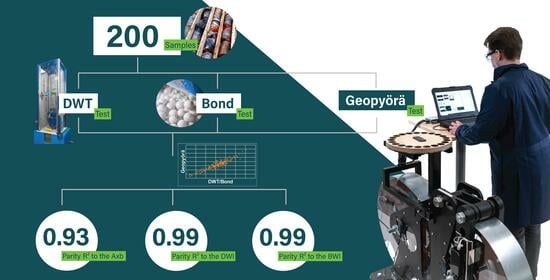2.1. Geopyörä Procedure
Geopyörä is an instrumented roll crusher with an adjustable gap to measure applied forces and energy consumed during breakage of individual rock particles. The prototype was developed at the University of Oulu (Oulu, Finland) and consists of two instrumented wheels, which have an adjustable gap [
5]. The principle utilizes a controlled degree of crushing, with absorbed breakage energy being a response rather than an input. The steel wheels are powered via integrated electric motors placed in the frame, and the available energy ranges between 100 and 250 J [
5]. The device provides data on the impact force using a pair of strain gauges on the frame and measures the loss of rotational moment to determine the energy required for each particle breakage event. Since the creation of the prototype, a new product version of Geopyörä, which is pictured in
Figure 1, has been developed and entered into commercial operation in multiple laboratories around the world. Currently, there is ongoing work towards the development and design of new versions and updates.
The testing process can use both bulk and drill core samples, with the second option making use of halved or quartered one-meter sections of drill core. This allows one half/quarter of a core to be used for the breakage test, while the other part can be kept in archive or used for other purposes such as geochemical assaying [
7]. If limited sample is available, the breakage product can also be used for further testing when needed. Only one narrow particle size fraction is used, and samples are crushed and sieved to ensure that enough particles in the desired size are obtained for testing. The standard test uses two energy levels, with 20 to 30 randomly selected particles for each level, but the test can also be performed with three energy levels, which enables a more accurate test, but satisfactory results can be obtained even with just one level, albeit, in this case, using the high energy. Unlike the JKDWT or the SMC test, where nominal amounts of energy are applied by dropping a weight onto the sample, via the Geopyörä test, the energy is a measured response at the moment of breaking, and the level of this energy is adjusted through the wheel’s gap setting, which is defined as a percentage of the geometric mean of the size fraction being used, with a higher energy level requiring a tighter gap. The definitions of size range and energy levels used in the Geopyörä standard test show contrast with the complexity of other tests, which, using a larger number of intervals and energy levels, end up using a significantly larger number of samples.
Table 1 summarizes a comparison of the main breakage test requirements.
During the test, each particle is individually broken, and the software records the mass, the breaking force recorded by the load cells, and the energy loss of the wheels during the breaking event, with a correction to subtract the friction loss from the wheels. After the test, the breakage product is collected for subsequent sieving.
2.2. Samples and Methodology
A total of 204 samples from nine different deposits around the world in varying size ranges were used to perform this extensive validation of the Geopyörä results. Samples were tested on the SMC test, as well as the standard Bond ball mill test [
6], while subsamples were prepared for testing via Geopyörä devices at partner laboratories following the standard sample selection and testing procedure, so that reference results could be obtained for the comparative analysis with the Geopyörä results. To ensure that the samples selected for the Geopyörä test were representative in relation to the samples selected for the SMC test, a comparative pre-analysis was performed using the
SG (Specific Gravity) values measured with the Geopyörä samples and those measured with the SMC test samples.
As shown in
Figure 2, all but one sample fell within the ±15% dispersion range, which indicates a very good parity between the samples that were sent for reference testing and those tested via the Geopyörä test. It is necessary to guarantee this parity because if there is a bias in the separation of the samples that travel to each destination, it is possible that this bias will propagate to the test results, causing variability when comparing the two results.
Table 2 summarizes the statistical results of the comparison, where σ is the standard deviation and µ the mean of the data set.















